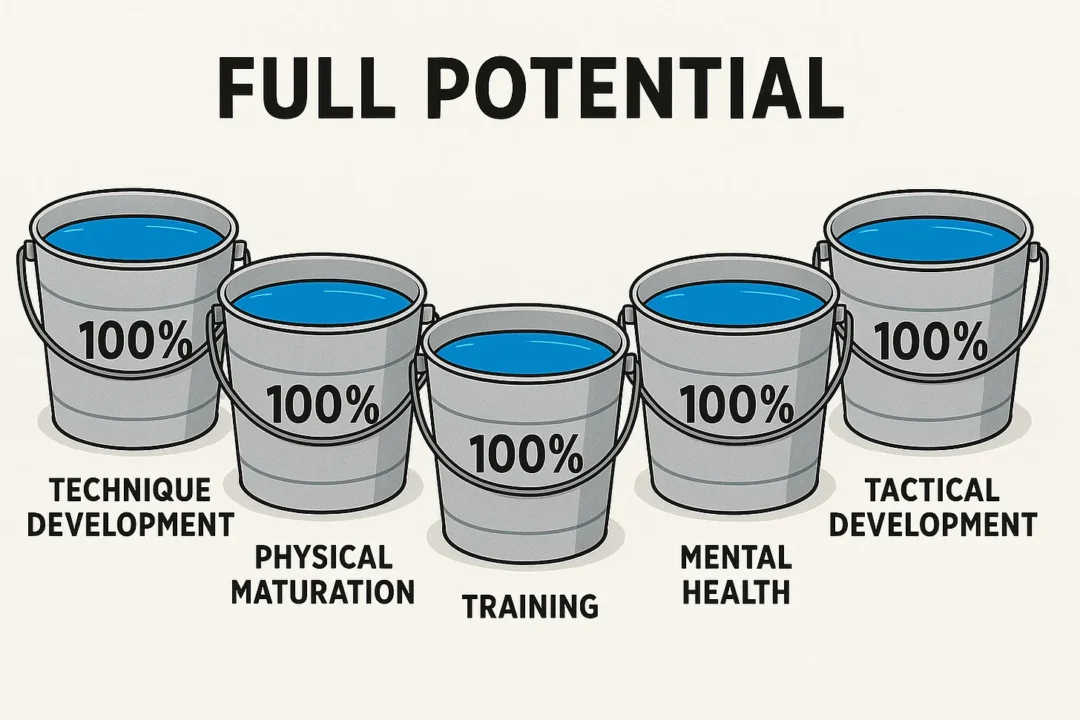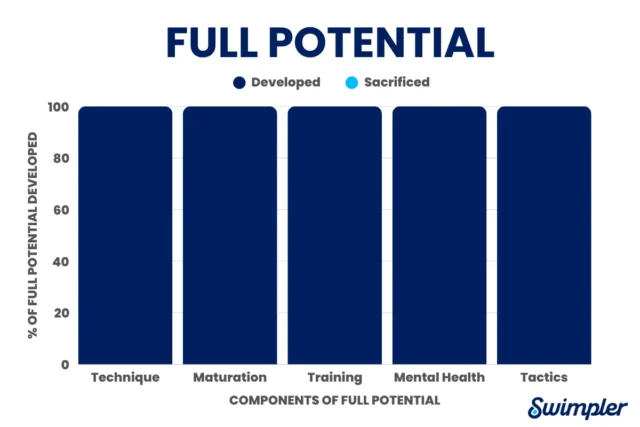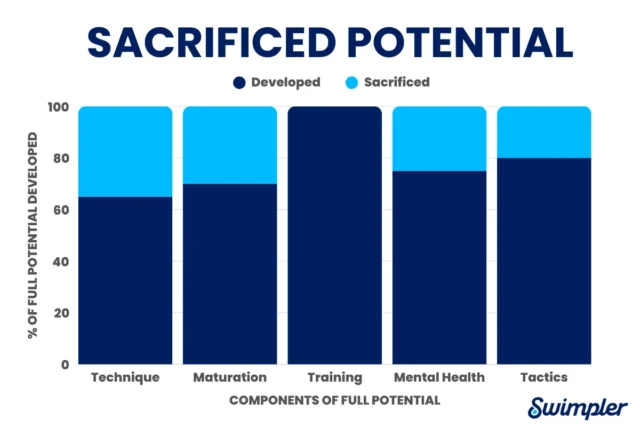Courtesy: Doug Cornish, the founder of Swimpler. Follow Swimpler on Substack here.
While drafting Volume 3 – Full Potential, I hit a wall. Every path toward illuminating “full potential” kept circling back to one barrier for comprehension: repetition.
After tackling repetition head-on in the last volume, readers now have a better understanding of how the prescription of repetition interferes with the development of full potential.
“Repetition is Our Nemesis,” is now a necessary precursor to this article.
In Volume 1, I mentioned Eddie Reese and his thoughts on the importance of technique. In that article, Eddie offered an overlooked insight on potential:
“The first is that most swimmers—the vast majority—only reach about 90 percent of their potential. A swimmer who goes beyond 90 percent, that’s rare, but that’s the nature of the beast. Now, if you don’t have fundamentally sound strokes, you can only achieve about 90 percent of your 90 percent. That equals 81 percent.”
We talk about “potential” constantly in this sport—but what does it actually mean?
If we can’t define it, how can we expect to develop it? Let’s build a working definition—and then expose how our current model consistently prevents swimmers from reaching it.
Operational Definition:
Full potential is the fulfillment and convergence of five developmental areas:
Technique Development, Physical Maturation, Training, Mental Health, Tactical Development
If even one of these is underdeveloped, a swimmer’s true potential remains out of reach.
Recognize that each category can be broken down into several subcategories. This article is meant to be a surface-level look at full potential.
1. Technique Development
Volume 1 of this series explored how excessive repetition locks in substandard technique.
In hundreds of clinics throughout my career, I have never had a swimmer attend a butterfly clinic and perform butterfly kick correctly on the first attempt. In fact, when I do clinics, I forewarn coaches about what they are about to see and how we are going to address it.
Take this example from a recent clinic. During a short break, Coach Megan Bilko of PEAQ asked me to assess her butterfly kick. I showed her the flaw, ran her through a simple stationary drill, and on the very next lap—no warmup, no buildup—she nailed it.
That’s the power of targeted technique education. No magic. Just awareness, simplicity, and coaching.
Good butterfly kick isn’t optional. It’s critical.
So why is it such an undeveloped skill in swimming?
- Coaches aren’t being properly educated
- Our system prioritizes quantity over quality
The result? Swimmers across the country are not learning the correct skills AND locking in flawed ones. Understanding that those are two different things is necessary for realizing why most swimmers leave their technique development bucket half full.
2. Physical Maturation
Swimmers are quitting the sport before they reach physical maturity.
Research by Allen and colleagues (2014, 2015) shows that male Olympic swimmers peak at age 24 – females peak at 22, while the NCAA states that only 9.4% of high school swimmers continue competing in college.
Even without more statistics, the reality is clear: swimmers overwhelmingly exit the sport before their bodies are fully developed.
Our model doesn’t just limit development—it nearly slams the door on full potential before maturation is even possible.
3. Training
We excel at building aerobic engines—but that’s only one gear.
When consulting with teams on training cycles, I ask:
Are you overdeveloping aerobic systems while neglecting anaerobic power and race-specific utilization?
Great training isn’t about volume. It’s about alignment with race demands.
One last thought on training: Want to enhance your training bucket?
Optimize recovery so that the intended benefit of overload is actually realized.
4. Mental Health
We’ve all read about elite athletes taking breaks for mental health. I commend them for their honesty.
It’s as if these athletes sense the risks of prolonged participation at the highest levels and are trying to spare the next generation.
Mental strength works like muscle strength. Overload must be followed by rest, evaluation, and recovery. Growth is the goal. But too many athletes are breaking down.
To perform at their best, swimmers need to be resilient, emotionally balanced, and happy.
Want a place to start understanding this breakdown? Ask ChatGPT:
What are the symptoms of chronic glycogen depletion and how does it apply to competitive swimmers?
Please go down that academic rabbit hole, for the sake of your swimmers and your team.
5. Tactical Development
This is one of the most undervalued aspects of full potential. Tactical development refers to race strategy.
Swimmers can’t reach full potential without repeatedly planning, executing, and refining race strategies and outcomes. The two primary obstacles to maintaining velocity in a race? Technical breakdown and bonking. Strategy should directly address both.
I used to tell my swimmers and parents: You need to swim a specific race at least 20 times before you understand the synergy between practice design and race execution.
The Problem With Our Current Model
Swimming’s developmental model places training at the top of the priority list. But here’s what that gets us:
- Substandard technique gets locked in
- Frustration rises during plateaus
- Mental and physical health suffers
- Swimmers leave the sport before reaching maturity
Let’s use a simplified, conceptual model to visualize how underdeveloped categories compound. This isn’t exact math—it’s a conceptual tool:
- Training = 100%
- Tactical = 80%
- Technique = 65%
- Mental Health = 75%
- Maturation = 70%
Let’s apply Eddie’s logic of multiplying fractions:
100% x 80% x 65% x 75% x 70% = 27%
That means a swimmer in today’s model may only be realizing 27% of their full potential.
You may think that’s low.
I think it’s the beginning of understanding why our attrition rates are so high.
If full potential is our goal, then our chosen developmental model demands more.
Balance. Patience. Skill mastery. Joy. Systematic progression.
Anxiety and uncertainty are rippling through our sport. But I believe we’re standing on the edge of something extraordinary: the opportunity to reshape the future of swimming.
Swimmers. Coaches. Parents. Organizations. The time has come for a new narrative—and a new developmental model.
It’s time to embrace THE IMPERATIVE: IMPROVED TECHNIQUE DEVELOPMENT.



The requirement to succeed in swimming is by offering your entire youth in exchange for a little bit of extra speed a couple times a season….much less as you get older. It’s an unsustainable concept. Less swimming (no long course) until kids are 16 would be my thought and if possible, quit making kids wake up at 4:30 in the morning. They need to have other life experiences in order to enjoy the most intense one in their lives
Love this – I have a daughter that I believe is perfectly poised to benefit from this 🤞🏻
“Swimming’s developmental model places training at the top of the priority list.” Not necessarily true. The best coach balances technique, training, and mentality to produce the best results. Each athlete is different. Not every coach can learn and deliver the balance. Not every swimmer can maintain the balance. But, yes, when it’s all said an done, some athletes reach their potential more than other athletes. It’s not for lack of trying for many coaches and many athletes.
Exactly. The best do. Many do not. I’m hoping to provide a rationale to enhance technique development both within a coach and a team’s developmental structure. I’ve coached in NC, NJ, and PA. I now do clinics for teams. The number 1 obstacle that I have seen to swimmer improvement and longevity is not a lack of practices or yards swum. It’s a lack of technique knowledge and development.
Doug, I hear ya. I know 20+ year veteran coaches who have no idea how to spot, never less fix a technical deficiency. I suppose I am a bit jaded but feel that many coaches just will never learn how to improve technique. I really have absolutely no idea how someone can stand on a pool deck for 20 years and not have a top 10 list of deficiencies to look for and their tried and true solution to fix it. I just think the best coaches can see and focus on technique as they train the swimmers.
Attrition rates are high because to get better, it takes more work. More work is hard. Very few kids of any age are willing to work that hard considering other factors that make life fun (staying up late, eating junk food, doom scrolling, sleeping in, having a family and spending meaningful time with them that isn’t at a boring swim meet). Also, what is 100% potential when even Katie Ledecky hasn’t reached her 100% potential? How many kids have the mindset of Katie Ledecky (reason why she is our top 1%)?
After coaching for over 20 years, I can affirm that some swimmers leave because they don’t want to do the work. However, if every coach has the mindset that swimmers being lazy is the main cause of attrition, then our sport is doomed.
I am not suggesting that kids are lazy. I am coming at it from a cost benefit analysis. For a lot of kids, the cost of pushing harder in the pool and weightroom, or just sacrificing enjoyable things like junk food and staying up late, is too much. You have to love the work to maximize the potential, and that love has to be very high on the priority list. I have seen this specifically with post pubescent girls where the only option to get faster is work harder, get in the weight room to get stronger and make sure fueling the body is a top priority. Then all that work translates into what?? A time drop that will get… Read more »
That’s fair…and a great reply. It’s really hard to watch kids who put years into it walk away for any reason. Those kids, like you say, are making cost-benefit decisions. I don’t know the stats, but I’d bet we lose far more beginners who are just subjected to yardage. And while it really is a shame to lose a long-dedicated swimmer, the continued reluctance to address our developmental model is hurting our sport by pushing potential swimmers and rational parents in other directions.
Additionally, there’s scientific and practical reasons, as stated in the series, to believe that making skill development (rather than volume) the priority will better enable the development of full potential.
Probably when this pressure is absent many of them come back later as masters swimmers and say that finally they enjoy swimming and focusing on technical skills. I even saw people who improved their technique comparing to their youth and post personal bests.